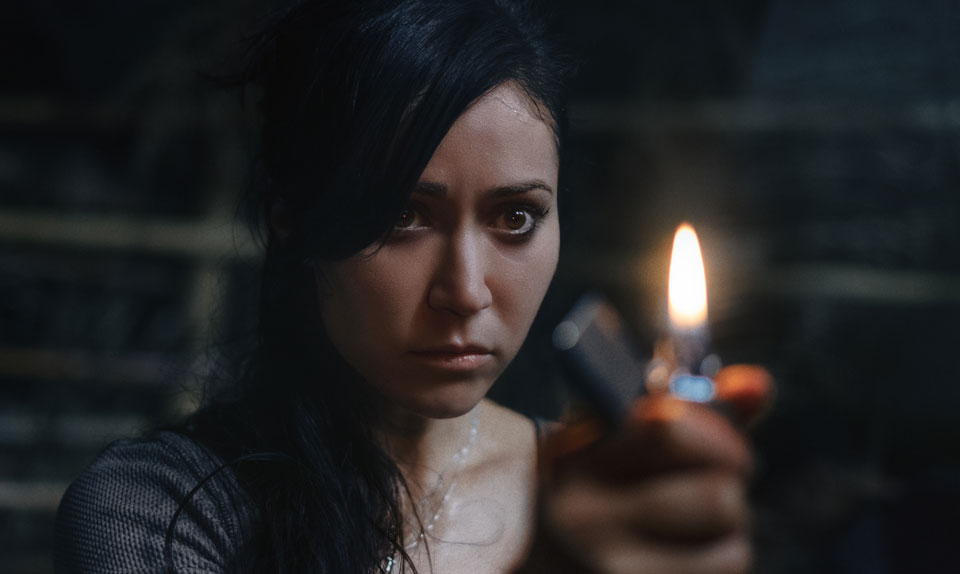
When we think of movies that focus on religion, particularly in the United States, Catholicism and Christianity seem to have cornered the market. Questions about the existence of Heaven, the power of faith, and things that go bump in the night are far too often portrayed from a perspective that places Euro-centric notions at the heart of those matters. The horror film The Old Ways shatters that picture.
The movie takes on the popular (and sometimes overdone) horror theme of exorcisms, de-centers Catholicism, and infuses a chilling story of possession with indigenous Mexican culture and traditions. A priest is not the beacon of spirituality in this film. By focusing on the bruja, (witch woman), the shackles of what counts as legitimate religion and what is relegated to mythos are thrown off for a wild ride into demons, identity, and truth.
Written by Marcos Gabriel, The Old Ways follows Cristina Lopez, a Mexican-American reporter who returns to her hometown near Veracruz for a story. Lopez has secrets, and her problems get even worse when she is seemingly abducted by a witch woman and her assistant who insist that Cristina is being possessed by a demon. They want to perform an exorcism, while Cristina just wants them to let her go as she does not believe in the kind of possession they think has taken hold of her. What follows is an hour-and-a-half of a woman grappling with not only some supernatural entity but also the past traumas that still haunt her. The Old Ways goes beyond the spectacle of the exorcism aesthetic and zeroes in on what demons can symbolize in our own reality and what healing is allowed to look like. This makes for good storytelling with a hip spin on a narrative many viewers have seen before.
The film wastes no time getting started. Viewers will be shaken as our protagonist when the movie opens and they find her sitting in a small room on a bare bed with a sack over her head. She doesn’t know what is going on, and neither do we. The exposition is sprinkled throughout the action, with viewers getting pieces of Cristina’s backstory bit by bit as things progress. She’s a woman far removed from the culture she was born into, and that may be part of why this mysterious dark entity has a hold on her.
Director Christopher Alender keeps things simple. There is always a sense of foreboding in the air, but it is balanced by moments of appropriately placed levity. We get intimate moments with the characters interwoven with the darker moments of fear and supernatural spectacle. It’s clear that this isn’t just a story about a monster; it’s also about people. Monsters are thrown in for good measure, and they are worth the watch, but they aren’t center stage. The gore is not gratuitous, but rather symbolic of the excruciating self-reflective journey Cristina has to take.
The alienation we are made to feel from her comes off as symbolic of the alienation of a people losing their traditions. That feeling is deliberate, a way to convey the deeper message the film wants to communicate to its audience. It’s a message dealing with history, oppression, and colonization.

Before the Americas were colonized, the land known as Mexico was inhabited by many indigenous tribes. When Spaniards arrived, they brought with them unfamiliar diseases, war, and oppression—all of which combined to decimating the peoples that were originally on the land. Although assimilation and infusion of these cultures happened over the years, Spain forcibly imported Catholicism, which soon became a big part of Mexican culture. Yet, there were faiths and beliefs before colonialists brought their religion. The Old Ways, along with a title that drives home that point even further, takes the stance—via Cristina’s tribulations—that those old ways are just as powerful and argues there’s a real danger of them being lost.
There’s something empowering about this narrative as well. In other exorcism movies, one can be made to feel like the fate of those affected rests in the hands of some unseen entity. A sense of powerlessness can settle in. And that negative feeling doesn’t seem so far removed from some Catholic doctrines that lean more on somberness than jubilation. To be sure, there is joy in this film. The realization and actualization are powerful to witness, even if it isn’t all rainbows and sunshine.
Brigitte Kali Canales, who plays Cristina, and Andrea Cortés, who plays Critstina’s cousin Miranda, give wonderful performances of vulnerability and strength. They, along with other actresses of color in recent years, are helping to redefine what a “final girl” in horror movies is allowed to look and act like. Julia Vera, who plays the bruja exorcist, has a strong haunting presence whenever she is on screen that will stay with viewers. The language she speaks in the film is called Náhuatl, and I encourage viewers to look up the history of it in Mexico. It’s authentic touches like these in the movie that truly help it stand out.
The Old Ways does not overstay its welcome, with a runtime of 90 minutes, but the conclusion will leave audiences curious as to where the story goes after the credits roll. Not all the questions are answered, and some things are left vague, which may frustrate some viewers. If you’re looking for intense gore and special effects that lean heavily on CGI, you (thankfully) won’t find that here. Come for the exorcism, stay for the compelling story. No holy water required.
The Old Ways is now available on Digital/Blu-ray/DVD and is currently streaming on Netflix.










